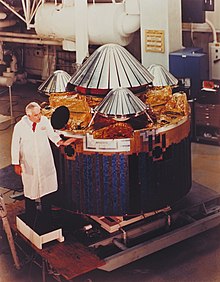શુક્ર (ગ્રહ)
![Venus in approximately true-color, a nearly uniform pale cream, although the image has been processed to bring out details.[૧] The planet's disk is about three-quarters illuminated. Almost no variation or detail can be seen in the clouds.](http://upload.wikimedia.org/wikipedia/commons/thumb/e/e5/Venus-real_color.jpg/250px-Venus-real_color.jpg) Venus in true-color. The surface is obscured by a thick blanket of clouds. | |||||||||||||
| Designations | |||||||||||||
|---|---|---|---|---|---|---|---|---|---|---|---|---|---|
| Pronunciation | /ˈviːnəs/ ( | ||||||||||||
| Adjectives | Venusian or (rarely) Cytherean, Venerean | ||||||||||||
| Orbital characteristics[૪] | |||||||||||||
| Epoch J2000 | |||||||||||||
| Aphelion |
| ||||||||||||
| Perihelion |
| ||||||||||||
| |||||||||||||
| Eccentricity | 0.006 756 | ||||||||||||
| 583.92 days[૨] | |||||||||||||
Average orbital speed | 35.02 km/s | ||||||||||||
| 50.115° | |||||||||||||
| Inclination |
| ||||||||||||
| 76.678° | |||||||||||||
| 55.186° | |||||||||||||
| Known satellites | None | ||||||||||||
| Physical characteristics | |||||||||||||
Mean radius |
| ||||||||||||
| Flattening | 0[૫] | ||||||||||||
| |||||||||||||
| Volume |
| ||||||||||||
| Mass |
| ||||||||||||
Mean density | 5.243 g/cm3 | ||||||||||||
| 10.36 km/s | |||||||||||||
| −243.018 5 day (Retrograde) | |||||||||||||
Equatorial rotation velocity | 6.52 km/h (1.81 m/s) | ||||||||||||
| 177.3°[૨] | |||||||||||||
North pole right ascension |
| ||||||||||||
North pole declination | 67.16° | ||||||||||||
| Albedo | |||||||||||||
| |||||||||||||
| 9.7"–66.0"[૨] | |||||||||||||
| Atmosphere | |||||||||||||
Surface pressure | 93 bar (9.3 MPa) | ||||||||||||
| Composition by volume |
| ||||||||||||
શુક્ર સૂર્યમંડળ નો દ્વીતીય ગ્રહ છે. સામાન્ય રીતે રાત્રીના આકાશનો આ સૌથી તેજસ્વી ગ્રહ છે. શુક્ર પૃથ્વીનો ભગીની ગ્રહ ગણાય છે.તેનું બાહ્ય વાતાવરણ કાર્બન ડાયૉકસાઇડ ના સફેદ વાદળો નુ બનેલું છે. તેની કક્ષા ગૉળાકાર છે.તેને કૉઇ ચંદ્ર નથી.
શોધખોળ[ફેરફાર કરો]
પ્રારંભિક પ્રયાસ[ફેરફાર કરો]
શુક્ર, તેમજ અન્ય કોઇ પણ ગ્રહ માટે, પ્રથમ રોબોટિક અવકાશયાન મિશન, 12 ફેબ્રુઆરી 1961 માં વિનેરા 1 યાન ના પ્રક્ષેપણ સાથે શરૂ થયો. તે સોવિયેત વિનેરા કાર્યક્રમ હેઠળ પ્રથમ વાહન હતું. વિનેરા 1 મિશને સાતમે દિવસે સંપર્ક ગુમાવી દિધો, ત્યારે તે પૃથ્વી થી 20 કરોડ કિમી ની દૂરી ઉપર હતો.[૧૩]
શુક્ર્ માટે સંયુક્ત રાજ્ય અમેરિકા નો શોધખોડ પણ પ્રક્ષેપણ સ્થળ પર મેરિનર 1 અવકાશયાન ને ગુમાવવા સાથે ખરાબ પરિસ્થિતિ માં શરૂ થયો. 14 ડિસેમ્બર 1962 ના તેમના 109-દિવસીય કક્ષીય સ્થળાંતર સાથે જ તે શુક્ર ની ધરતી થી 34,883 કિમી ઉપર થી પસાર થવા વારો દુનિયા નો પ્રથમ સફળ આંતરગ્રહીય મિશન બની ગયો. આ ના માઈક્રોવેવ અને ઇન્ફ્રારેડ રેડિયોમીટર થી ખબર પડી કે શુક્ર ના સૌથી ઉપરી વાદળ શાંત હતા જ્યારે પૂર્વ ના પૃથ્વી-આધારિત માપનો એ શુક્ર ની સપાટી ના તાપમાન ને ખૂબ ગરમ (425० સેંટીગ્રેડ) હોવાની પુષ્ટિ કરી છે, [૧૪] અને આના સાથે આ આશા પણ સમાપ્ત થઇ ગઇ કે આ ગ્રહ ભૂમિ-આધારિત જીવન નુ ઠેકાણું હોઇ શકે છે. મેરિનર 2 એ શુક્ર ના દડ અને ખગોળીય અંતર ને વધુ સારી રીતે મેળવ્યો, પર તે ચુંબકીય ક્ષેત્ર અથવા કિરણોત્સર્ગ પટ્ટો શોધવા માટે અસમર્થ હતું. [૧૫]
વાતાવરણીય પ્રવેશ[ફેરફાર કરો]

સોવિયત વિનેરા 3 યાન, 1 માર્ચ 1966 માં શુક્ર ઉપર ઉતરતા વખતે દુર્ઘટનાગ્રસ્ત થઇ ગયો. વાયુમંડળ મા પ્રવેશ કરનાર અને કોઇ પણ બીજા ગ્રહ ની સપાટી થી ટકરાવવા વારી આ પ્રથમ માનવ-નિર્મિત વસ્તુ હતી. ભલે આની સંચાર પદ્ધતિ નિષ્ફળ થઇ ગઇ પણ એના પહેલા તે તમામ પ્રકાર ની ગ્રહીય માહિતી વહન કરવા માટે સક્ષમ હતું. [૧૬]
સંદર્ભો[ફેરફાર કરો]
- ↑ Lakdawalla, Emily (21 September 2009), Venus Looks More Boring than You Think It Does સંગ્રહિત ૨૦૧૨-૦૧-૦૬ ના રોજ વેબેક મશિન, Planetary Society Blog (retrieved 4 December 2011)
- ↑ ૨.૦ ૨.૧ ૨.૨ ૨.૩ Williams, David R. (15 April 2005). "Venus Fact Sheet". NASA. મેળવેલ 2007-10-12.
- ↑ "The MeanPlane (Invariable plane) of the Solar System passing through the barycenter". 3 April 2009. મૂળ માંથી 2009-05-14 પર સંગ્રહિત. મેળવેલ 2009-04-10. (produced with Solex 10 સંગ્રહિત ૨૦૦૮-૧૨-૨૦ ના રોજ વેબેક મશિન written by Aldo Vitagliano; see also Invariable plane)
- ↑ Yeomans, Donald K. "HORIZONS System". JPL Horizons On-Line Ephemeris System.—At the site, go to the "web interface" then select "Ephemeris Type: ELEMENTS", "Target Body: ગુ" and "Center: Sun".
- ↑ ૫.૦ ૫.૧
doi: 10.1007/s10569-007-9072-y
This citation will be automatically completed in the next few minutes. You can jump the queue or expand by hand - ↑ "Report on the IAU/IAG Working Group on cartographic coordinates and rotational elements of the planets and satellites". International Astronomical Union. 2000. મૂળ માંથી 2011-08-10 પર સંગ્રહિત. મેળવેલ 2007-04-12.
- ↑ ૭.૦ ૭.૧ Mallama, A.; Wang, D.; Howard, R.A. (2006). "Venus phase function and forward scattering from H2SO4". Icarus. 182 (1): 10–22. Bibcode:2006Icar..182...10M. doi:10.1016/j.icarus.2005.12.014.
- ↑ Mallama, A. (2011). "Planetary magnitudes". Sky and Telescope. 121 (1): 51–56.
- ↑ "HORIZONS Web-Interface for Venus (Major Body=299)". JPL Horizons On-Line Ephemeris System. 2006-Feb-27 (GEOPHYSICAL DATA). મેળવેલ 2010-11-28. Check date values in:
|date=(મદદ) (Using JPL Horizons you can see that on 2013-Dec-08 Venus will have an apmag of −4.89) - ↑ Espenak, Fred (1996). "Venus: Twelve year planetary ephemeris, 1995–2006". NASA Reference Publication 1349. NASA/Goddard Space Flight Center. મેળવેલ 2006-06-20.
- ↑ "Venus: Facts & Figures". NASA. મૂળ માંથી 2006-09-29 પર સંગ્રહિત. મેળવેલ 2007-04-12.
- ↑ "Space Topics: Compare the Planets: Mercury, Venus, Earth, The Moon, and Mars". Planetary Society. મેળવેલ 2007-04-12.
- ↑ Mitchell, Don (2003). "Inventing The Interplanetary Probe". The Soviet Exploration of Venus. મેળવેલ 2007-12-27.
- ↑ Mayer, McCullough, and Sloanaker; McCullough; Sloanaker (1958). "Observations of Venus at 3.15-cm Wave Length". Astrophysical Journal. The Astrophysical Journal. 127: 1. Bibcode:1958ApJ...127....1M. doi:10.1086/146433. Unknown parameter
|month=ignored (મદદ)CS1 maint: multiple names: authors list (link) - ↑ Jet Propulsion Laboratory (1962). "Mariner-Venus 1962 Final Project Report" (PDF). SP-59. NASA. Cite journal requires
|journal=(મદદ) - ↑ Mitchell, Don (2003). "Plumbing the Atmosphere of Venus". The Soviet Exploration of Venus. મેળવેલ 2007-12-27.
